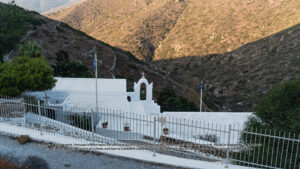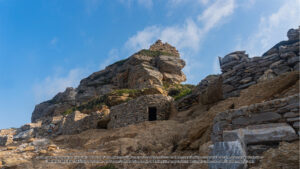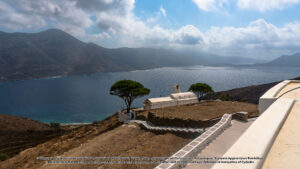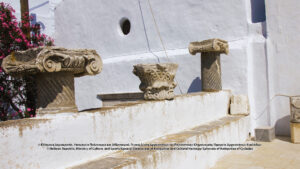In Kato Meria of Amorgos, in the southwestern part of the island, at a distance of 20 km from the Chora, after the crossroads for the beach of Kalotaritissa, 2 km from the village of Kalofana, the road leads to the church of Agia Paraskevi. About 500 meters further, it ends at a small beach with pebbles and stones, Paradisia, a real little paradise.
According to a local legend, in the place where the Holy Church stands today, the icon of Agia Paraskevi was found by a shepherd among the building remains of an older sanctuary. A small church was built at the site of the icon, which was renovated two or three times. The icon was considered miraculous, healing the eyesight and, as it became known, a festival began, small in the beginning, which over time evolved into the largest in the Cyclades. A brilliant two-day festival is organized uninterruptedly, every year on the 25th and 26th of July, on the eve and on the day of the feast of Agia Paraskevi, the largest traditional festival of all the Cyclades, with the participation of about 4,000 believers. Its main feature is the voluntary offer, in materials and work, by the inhabitants, mainly of Kato Meria Amorgos, due to proximity.
Preparations begin on July 17, the day of the feast of Agia Marina, with the cleaning and whitewashing of the Holy Church of Agia Paraskevi and all other facilities that have been built to meet the needs of such a large event: rooms for volunteers and pilgrims, dining rooms, ovens, storage areas and other infrastructure. Most of the “servants” of the faith, that is, the volunteers who participate in the preparations of the festival, are farmers and stockbreeders.
Many years before the development of the road network and tourism, many believers came with animals from various parts of Amorgos and in boats from the surrounding islands, bringing offerings. The farmers from Amorgos and Koufonisia bring their own wheat and barley, as their offering, which is ground in the mill of Gavras. Barley is also brought by the pilgrims from Donoussa and Schinoussa, which is indeed famous for its specific product.
They also bring animals from Herakleia, oil and wine from Naxos, that is, what each island has, as an offering to the festival. The bread of the festival is made entirely on the premises of the church. From July 23, the kneading for the required 2,000 kilos of bread begins, which will be baked in the huge oven included in the church facilities, with a capacity of 56 loaves of two and a half kilos per batch. As soon as the bread starts to bake, the place smells wonderfully, especially with the “eftazimo”. The offerings of animals each year are around 200 sheep and goats, 4 calves, 1 cow and 4 pigs. Since most of the volunteers are farmers and stockbreeders, the animals are slaughtered by themselves in the adjacent slaughterhouse on the eve. During the week leading up to the celebration, the volunteers have picked up brushwood for the ovens to bake and have made all the preparation needed for cooking: potatoes, about 1,200 kg of onions, 200 kg of legumes and everything else needed for the food. On the eve and on the day of the feast, the cooking takes place, for which about 200 kilos of oil are required.
Everything is cooked in the kitchen of the church of Agia Paraskevi in very large cauldrons, on woods that are smoldering and have been collected from the mountains of Amorgos. The cauldrons require constant mixing, which is undertaken by those with stronger arms.
So, on the eve of the feast of Agia Paraskevi, July 25, 15 cauldrons of “patatato” and 2 cauldrons of “kofto” are set on fire, which will be served after Vespers. On the day of the feast, July 26, 6 cauldrons of “patatato” and 1 cauldron of “ksidato: are prepared, which this time will be served after the Divine Liturgy.
Vespers begin with the sunset, as the sun disappears behind the top of Mavrovouno. After Vespers, the believers gather standing in the churchyard, in a circle around the place where the breads of the feast will be blessed by the fellow priests and afterwards will be distributed. Subsequently, people move in dense groups to the large courtyard, with a capacity of 1,000 seated people. This is a configuration of the last years, in order to cover the increased needs of the celebration. Large tables are set here, the instruments are played and the dance takes place. Officials from Amorgos as well as from the surrounding islands, together with priests, gather in a separate room, in the dedicated space called “panigirospito”. In the past, when there was no large courtyard, the celebrants would take the food and spread out in the fields while the orchestras played in makeshift huts. It is noteworthy that for 18 consecutive years Archbishop Christodoulos also participated in the celebrations, a fact that increased the obligations of the vicars, while for the pilgrims it was a special occasion to meet him.
Generous portions of food are placed in deep ceramic dishes. The meal is accompanied by wine, which usually reaching 200 kg. About a hundred young men and women of the island serve and help in all the work with great fun and always with a smile on their face. When everyone sits at the tables, the orchestra begins to prepare, tuning the instruments and waiting for the vicars to start the dance first. This is an old custom that honors people who have worked hard for the holiday. The first dance is headed by the chief vicar and followed by the rest according to hierarchy. At that moment, a song is heard, written especially for him, the vicars and all the “servants” of the festival. The traditional feast with violins and lutes by Amorgian musicians continues until dawn, in the outdoor dining room of Agia Paraskevi, but also in bars and tavernas in the villages of Kato Meria. The morning service of the next day is short and very simple as from the people who had come for the Vespers, there are very few who come for the Divine Liturgy on the day of Agia Paraskevi, mainly the locals and the visitors who have come from different places of Amorgos and the Cyclades and have been hosted in the cells of the church, the vicars and the “servants”. For them, the festival ends after lunch, which is like a family gathering in the large hall of the “panigirospito” where the first assessments are made. The general cleaning of all facilities follows.
It is a celebratory process, forging a commitment to local tradition and preserving cultural continuity, social cohesion, generosity, and optimism for the future.
Means of access:
CAR
,
BUS
,
TAXI
Opening hours:
July 25th & 26th: the Holy Church remains open.
,
Apart from Celebration days: Holy Church: daily 16:00 pm -17:00pm. Communication with the Parish is required.
Entry fees:
Free





